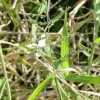Resumen
Paragrass (also referred to as Californiagrass) is thought to have been introduced into Florida sometime in the late 1870s as a forage plant. The semiaquatic grass is a native of tropical Africa, and today it is established in both hemispheres in tropical and subtropical regions as a highly palatable fodder. The grass is established in regions of poorly drained soils and along freshwater shorelines in Alabama, Florida, Hawaii, Maryland, Oregon, South Carolina, and Texas. It is an extremely aggressive competitor that can displace many shoreline emergent plants and plants in cultivated or disturbed sites associated with moist soil. Paragrass becomes readily established in wet soils along shorelines where it can form large monocultures. This 4-page fact sheet was written by L. T. Markle, B. A. Sellers, and W. A. Overholt, and published by the UF Department of Agronomy, April 2013.
Citas
Austin, D. F. 1978. "Exotic Plants and Their Effects in Southeastern Florida." Environ. Conserv. 5 (1): 25-34.
https://doi.org/10.1017/S0376892900005233
Chang-Hung, C. 1977. "Phytotoxic Substances in Twelve Subtropical Grasses I. Additional Evidences of Phytotoxicity in the Aqueous Fractions of Grass Extracts." Bot. Bull. Acad. Sinica 18 (2): 131-141.
Chaudhari, S., B. A. Sellers, S. V. Rockwood, J. A. Ferrell, G. E. MacDonald, and K. E. Kenworthy. 2012a. "Integrating Chemical and Cultural Practices to Control Para Grass (Urochloa mutica)." J. Aquat. Plant. Manage. 50: 39-45.
Chaudhari, S., B. A. Sellers, S. V. Rockwood, J. A. Ferrell, G. E. MacDonald, and K. E. Kenworthy. 2012b. "Non-Chemical Methods for Paragrass (Urochloa mutica) Control." Inv. Plant Sci. Manag. 5 (1): 20-26. https://doi.org/10.1614/IPSM-D-11-00026.1
Duke, J. A. 1983. "Handbook of Energy Crops." Unpublished report. Purdue University Center for New Crops and Plants Products. Accessed April 2013. http://www.hort.purdue.edu/newcrop/duke_energy/Brachiaria_mutica.html.
Florida Fish and Wildlife Conservation Commission (FWC). 2011. Invasive Plant Management Section Annual Aquatic Plant Survey, 2011. Accessed April 2013. http://myfwc.com/wildlifehabitats/invasive-plants/aquatic-plant/.
Godfrey, R. K., and J. W. Wooten. 1979. Aquatic and Wetland Species of the Southeastern United States: Monocotyledons. Athens: University of Georgia Press.
Hall, D. W. 1978. "Poaceae: The Grasses of Florida." PhD diss., University of Florida, Gainesville, FL.
Handley, L. L., and P. C. Ekern. 1981. "Irrigation of California Grass with Domestic Sewage Effluent: Water and Nitrogen Budgets and Crop Productivity." Unpublished report. University of Hawaii at Manda.
Langeland, K. A., and K. Craddock Burks. 1998. Identification and Biology of Non-native Plants in Florida's Natural Areas. SP257. Gainesville: University of Florida Institute of Food and Agricultural Sciences.
Napper, D. M. 1965. "Grasses of Tanganyika." Bull. No. 18. Tanzania: Ministry of Agriculture, Forests and Wildlife.
Thayer, D. D., K. A. Langeland, W. T. Haller, and J. C. Joyce. 2003. Weed Control in Florida Ponds. CIR 707. Gainesville: University of Florida Institute of Food and Agricultural Sciences.
Vicente-Chandler, J., F. Abruna, R. Caro-Costas, J. Figarella, S. Silva, and R. W. Pearson. 1974. "Intensive Grassland Management in Humid Tropics of Puerto Rico." Unpublished report. Rio Pedras: University of Puerto Rico Agricultural Experiment Station.
Wunderlin, R. P., and B. F. Hansen. 2011. Guide to the Vascular Plants of Florida, 3rd edition. Gainesville: University Press of Florida.
Unless otherwise specified, articles published in the EDIS journal after January 1, 2024 are licensed under a Creative Commons Attribution-NonCommercial-NoDerivs 4.0 International (CC BY-NC-ND 4.0) license.

